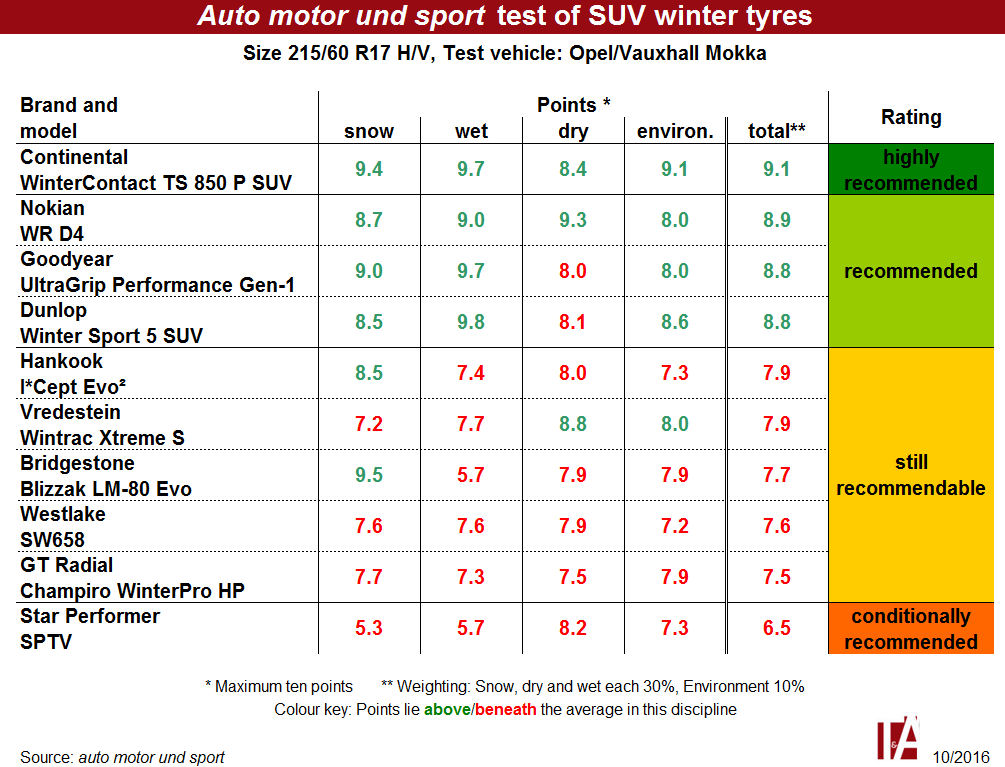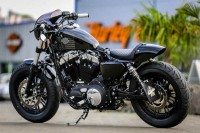Ams winter tyre test: a win for Continental

Following its test of all-season SUV tyres, German car magazine auto motor und sport (ams) has now turned its attention to dedicated winter tyres. The same model vehicle, an Opel/Vauxhall Mokka, saw service once again as test car for the comparative evaluation of ten size 215/60 R17 H/V winter products. The tyres were tested for snow, wet and dry performance, with each of these counting 30 per cent towards the final score, with the remaining ten percent reserved for environmental criteria.
The Continental Winter Contact TS 850P SUV came closest to the maximum ten point total with a score of 9.1, a result that handed the tyre both victory in the test and a ‘highly recommended’ rating. The ams testers deemed the Continental tyre to have outstanding winter and wet characteristics, including lightly understeering handling and “exemplary braking and traction,” however they saw room for improvement when it came to dry braking and rolling noise.
Close behind the test winner with 8.9 points was the Nokian WR D4. Although the tyre demonstrated a light propensity to oversteer in the wet and snow and “somewhat sluggish steering behaviour,” its above-average winter characteristics, outstanding resistance to aquaplaning and short, safe braking distances on wet and dry surfaces ensured a high score and a ‘recommended’ rating.
Two Goodyear Dunlop products – the Goodyear UltraGrip Performance and Dunlop Winter Sport 5 SUV – also gained a rating of ‘recommended’ by finishing just behind the Nokian tyre. The pair shared third place with 8.8 points, with both delivering convincing, well-balanced driving performance on wintery road surfaces. Neither tyre disgraced itself in the wet or dry, either. A certain load change sensitivity was observed in the Goodyear tyre, however, thanks to a “nervous rear axle” on snow, while the Dunlop tyre was considered to give steering response times that were perhaps a tad on the slow side. Its “bounciness” also affected comfort, the testers reported. Ams notes that the joint third place holders are new to the market, and their evaluation in the current test must later be confirmed once the tyres are available in the retail market.
The next two tyres, the Hankook I*Cept Evo² and Vredestein Wintrac Xtreme S, finished the test with a total score of 7.9 points and a rating of ‘still recommendable’. The Hankook tyre lost points for deficits in the wet, for braking and lateral control, as well as what the testers described as a “narrow range of limits.” The Vredestein rubber, on the other hand, was marked down for a “notable disparity between lateral control and traction on snow” as well as “too long a braking distance and light oversteering on wet road surfaces,” as well as its aquaplaning performance. That said, the Hankook I*Cept Evo² and Wintrac Xtreme S were viewed as tyres with balanced driving characteristics in the snow and (Hankook) “dynamic, direct and stable on dry asphalt,” and (Vredestein) safe braking on snow and in the dry with “nearly sporting performance.”
The ‘still recommendable’ rating was extended to the next three tyres: The Bridgestone LM-80 Evo finished the test with a total score of 7.7 and good performance in the winter and environmental disciplines, however it showed weaknesses on wet road surfaces, including “very weak braking and elevated sensitivity towards load change and aquaplaning in the wet.” The Westlake SW658 garnered 7.6 points and presented neither pronounced strengths nor weaknesses. The ams testers characterised it as an “a properly well-balanced and a mostly easy to control tyre,” albeit at a “somewhat reduced level of performance.” Traction on snow was said to be just average. The situation for the ninth placed tyre, the GT Radial Champiro WinterPro HP wasn’t much different. The tyre scored 7.5 points and delivered short braking distances in the snow, safe dynamics in the dry and low rolling noise, together with long braking distances in the wet and dry, weaknesses in aquaplaning and high rolling resistance.
A score of just 6.5 points saw the Star Performer SPTV end the comparative evaluation in last place. While the tyre was able to keep pace in the dry, it displayed “very weak” winter performance and a “very long braking distance and pronounced load change sensitivity” on wet asphalt. The ams testers said it “wasn’t recommended for snowy regions.” The Star Performer gained a ‘conditionally recommended’ rating.




Comments